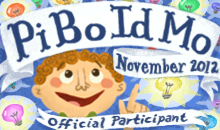You are currently browsing the monthly archive for April 2013.
 Artistic temperament sometimes seems a battleground, a dark angel of destruction and a bright angel of creativity wrestling. ~Madeleine L’Engle
Artistic temperament sometimes seems a battleground, a dark angel of destruction and a bright angel of creativity wrestling. ~Madeleine L’Engle
Creativity comes from looking for the unexpected and stepping outside your own experience. ~Masaru Ibuka
What do you do to bolster your creativity? The other day I needed to develop a craft for the book I’m currently writing for Legacy Press, and for the life of me, I just couldn’t come up with any good ideas. I put it aside, worked on other things, went for a jog by the river, returned to my desk, but still NADA! Finally, I remembered PINTEREST! Duh! That’s where I should have gone first. If you’ve never used this pin board, it’s a wonderful place for creativity. People pin photographs of things that are meaningful to them, recipes to try, books to read, hairstyles and clothing, just about anything! So I love to look there for ideas, that is, if I remember. Mind you, for this book I can’t copy a craft, but just being in a virtual place staring at boards of awesome creative ideas is wonderful for my brain. Somehow, it got the wheels turning, and I came up with a unique craft that had absolutely nothing to do with what I was even staring at.
So my take-away lesson is that if we want to be creative or find ideas, we need to be in a place surrounded by creativity. If we want to be wonderful writers, we have to surround ourselves with writings and teachings of other great writers. If we want to find ideas for children’s books, we must surround ourselves with children. Seems like very simple logic, but sometimes I think I forget.
What do you do to unearth your creativity? If you want to look me up on Pinterest, I’m at http://pinterest.com/tinamariecho/
I’m not on there a whole lot, as I have much to write and homeschool. But it’s a fabulous place, if you’ve never been.
I’m up to my elbows in “green” topics as I’m in the middle of writing a book for Legacy Press Kids, which is a chapter book with 10 chapters. This book is unique in that it’s classified as nonfiction; however, each chapter has a fiction story for 8-12 year-old-girls along with nonfiction facts, puzzles, activities, crafts, and devotions. I’ve never written a regular chapter book or novel, but this is great practice. I’m actually continuing the same characters this time throughout the book and adding new friends along the way. I’m also aware of my age group so that I use the proper sentence length and vocabulary. So that brings me to my book review below, which includes a section on how to write chapter books. I thank God I was in writing groups with Nancy I. Sanders. She basically taught me everything I know about writing. Now that we’re thousands of miles away, I still hound her and ask her questions. She’s an award winning author of over 80 books and does a superb job teaching others how to write.
 Book Review: Yes! You Can Learn How to Write Beginning Readers and Chapter Books by Nancy I. Sanders, 2012
Book Review: Yes! You Can Learn How to Write Beginning Readers and Chapter Books by Nancy I. Sanders, 2012
If you’d like to write for the educational market or just learn the differences between beginning readers, this is the perfect book. Nancy explains in detail the structures of the following: pre-emergent readers, emergent readers, easy readers, advanced readers, first chapter books, and hi-lo readers. Whew! She also touches on writing for children’s magazines and how to write a rebus.
If you want to know the nitty-gritty of this world of beginning readers, Nancy starts with the history of how it all came to be, reading levels, standards, word lists, etc…
Each reader section gives concrete examples of the structure: vocabulary, number of words in each sentence, characters, dialogue, plot, setting, topics and themes. She shows you how it all works together under very tight guidelines. I know. I’ve done it! See photo.
I appreciate Nancy’s expertise in sharing tips and strategies along with little assignments you can do to practice writing for this age group. Since chapter books are new to me, when I have some extra time, my kids are hounding me to write one. I’ll definitely use her chapter to help guide me. 
The back of the book has a wonderful glossary. When I started writing in 2008, I knew none of the writer lingo and was constantly asking Nancy questions, like why do they call publishing houses a house? What is a royalty check? So this is very helpful for beginning writers as well.
So if you’re interested in writing beginning readers or beginning chapter books, check out this book! Writing for this age group is so much fun!
[This is a spread from my guided reading book Flamingo’s Tricks published by Lakeshore Learning 2011. These are phonic readers, and each book correlated to specific sounds. This one corresponded to blends.]
If you’d like to get a feel for Nancy’s book, click here to read the transcript of a workshop she led on beginning readers for the Institute of Children’s Literature, March 2013.




